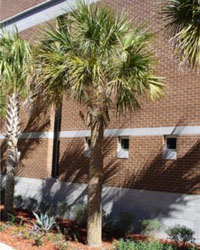Sabal palmetto - Cabbage palm



Family Arecaceae
Description:
About fifteen species of Sabal range from the southeastern U.S. into northern South America and the Caribbean. The cabbage palm is Florida's state tree. Wild populations of cabbage palm extend along the coast from southern North Carolina into Cuba. Typically, it has a single trunk although injuries to the growing point may cause branching. The youngest leaves and bud are sometimes eaten as palm cabbage or heart-of-palm, although the harvest of this bud kills the palm. The trunks have been used as construction timbers. The leaves were used for weaving and as a roof thatch by indigenous peoples of the southeastern U.S. The small black fruits are valuable as wildlife food.
Location:
This plant can be seen on the west side of building 45, the north side of building 39 and in natural areas around campus.
Size:
At fifty feet or more in height, it is the tallest of north Florida's native palms (royal palm in the south is taller.)
Care Instructions:
Light: full sun
Water: drought tolerant when established, responds well to irrigation
Soil: adaptable, no special requirements
Other - this plant is often over-pruned, removing green leaves is unnecessary and can be harmful to the plant
This native plant is commonly found in moist sites but is adaptable to drier sites in cultivation. Grow it in a sunny spot where the soil is not excessively dry, such as a sand ridge.
